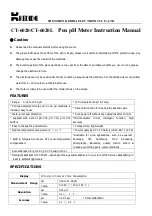
Appendix
EngyVolt RV15
48
response is identified by the function code being a copy of the query function code but with the
most-significant bit set. The data contained in an exception response is a single byte error code.
First Byte
Last Byte
"Slave" address
Function code
Error code
Error check (Lo)
Error check (Hi)
"Slave" address:
8-bit value representing the address of slave that is responding.
Function code:
8 bit value which is the function code in the query OR'ed with 80 hex, indicating that the slave
either does not recognize the query or could not carry out the action requested.
Error code:
-bit value indicating the nature of the exception detected, see table of error codes (
Error check (Lo):
The bottom (least significant) eight bits of a 16-bit number representing the error check value.
Error check (Hi):
The top (most significant) eight bits of a 16-bit number representing the error check value.
11.4.2 Serial transmission modes
There are two Modbus Protocol serial transmission modes, ASCII and RTU. EngyVolt devices do
not support the ASCII mode.
In RTU (Remote Terminal Unit) mode, each 8-bit byte is used in the full binary range and is not
limited to ASCII characters as in ASCII Mode. The greater data density allows better data throughput
for the same baud rate, however each message must be transmitted in a continuous stream. This is
very unlikely to be a problem for modern communications equipment.
Coding system
Full 8-bit binary per byte. In this document, the value of each byte will be shown as two
hexadecimal characters each in the range 0-9 or A-F.
Line protocol
1 start bit, followed by the 8 data bits. The 8 data bits are sent with least significant bit first.
User option of parity and
stop bits:
a) no parity & 2 stop bits
b) no parity & 1 stop bit
c) even parity & 1 stop bit
d) odd parity & 1 stop bit
User option of baud rate a) 2
400 b) 4
800
c) 9
600 d) 19
200
The baud rate, parity and stop bits must be selected to match the master’s settings.
11.4.3 Modbus protocol message timing
A Modbus protocol message has defined beginning and ending points. The receiving device
recognizes the start of the message, reads the “Slave Address” to determine if they are being
addressed and knowing when the message is completed they can use the Error Check bytes and
parity bits to confirm the integrity of the message. If the Error Check or parity fails then the message
is discarded.
In RTU mode, messages start with a silent interval of at least 3.5 character times. The first byte of
a message is then transmitted, the device address. Master and slave devices monitor the network
















































